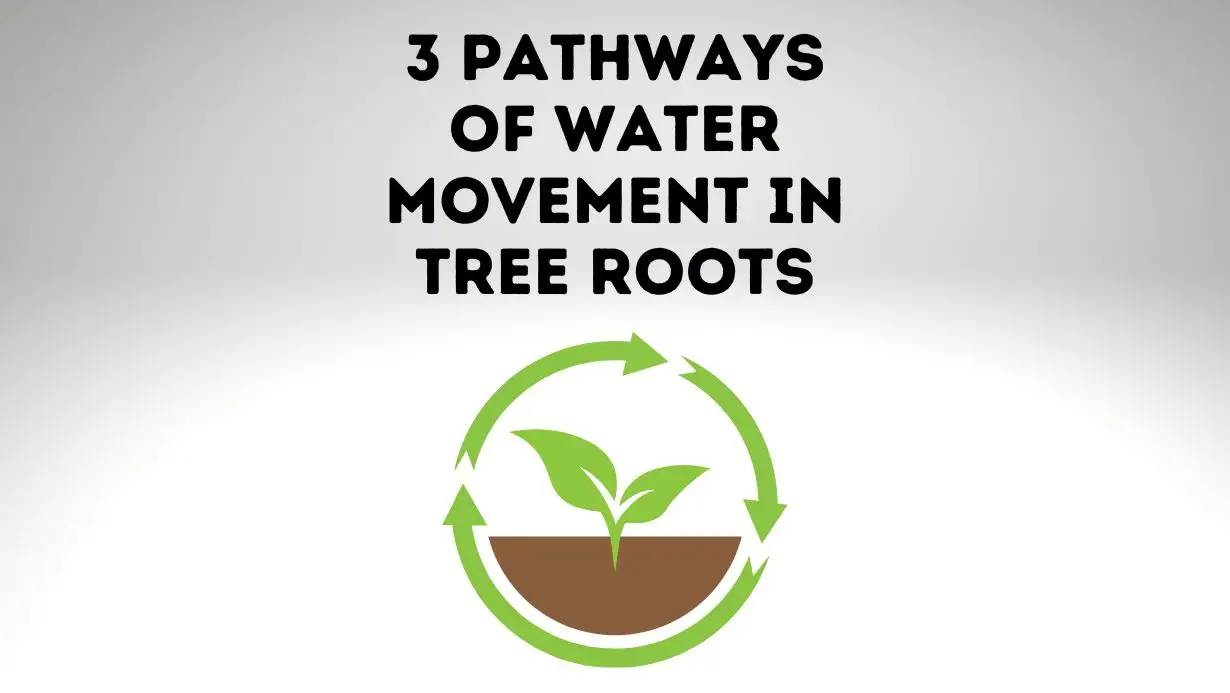
Tree roots absorb water, but have you ever wondered how the water is absorbed? There are three pathways the water can take. These are the apoplast, symplastic, or transmembrane pathways.
At a basic level, water travels into a tree’s fine roots. The water must then travel inside the root to the xylem. There are three different paths water can take to get to the xylem. This article will cover each pathway in depth.
Before reading this article, you may want to brush up on your root anatomy knowledge. This article will cover each piece of anatomy in-depth. And this article is an extensive guide to roots as a whole, with a brief look at their anatomy.
Osmosis refers to the diffusion of water through a semipermeable membrane NOT the diffusion of information through impermeable skulls
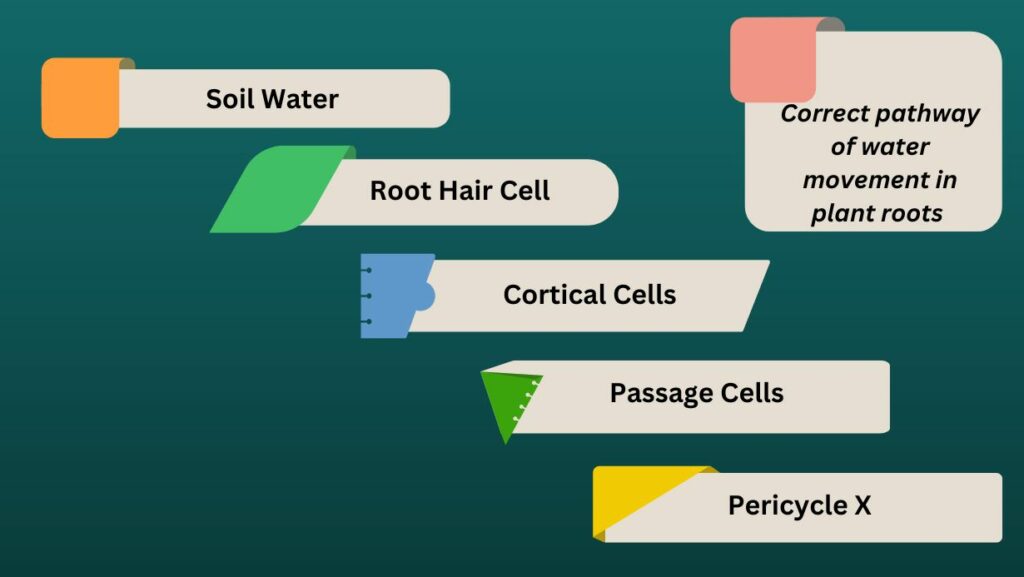
The correct pathway of water movement in plant roots is
Soil Water => Root Hair Cell => Cortical Cells => Passage Cells => Pericycle Xylem
Apoplast Pathway
When using the apoplast pathway, water will travel between cells. There will be tiny gaps between each cell. Water will move between these gaps.
Water must navigate these gaps as they move deeper inside the tree root. Eventually, the water will reach the endodermis. The endodermis is the inner skin of the tree root.
The endodermis controls how much water and nutrients move further inside the cell. The Casparian Strip helps with this process.
The Casparian Strip is a corky substance that prevents foreign material from getting deeper into the root. Something can only pass through the strip if that something is inside a cell.
So, to get past the Casparian Strip, water and nutrients need to enter a cell. Substances can enter a cell by moving through the cell’s plasma membrane.
After passing through the endodermis, the water can reach the tree’s vascular system.
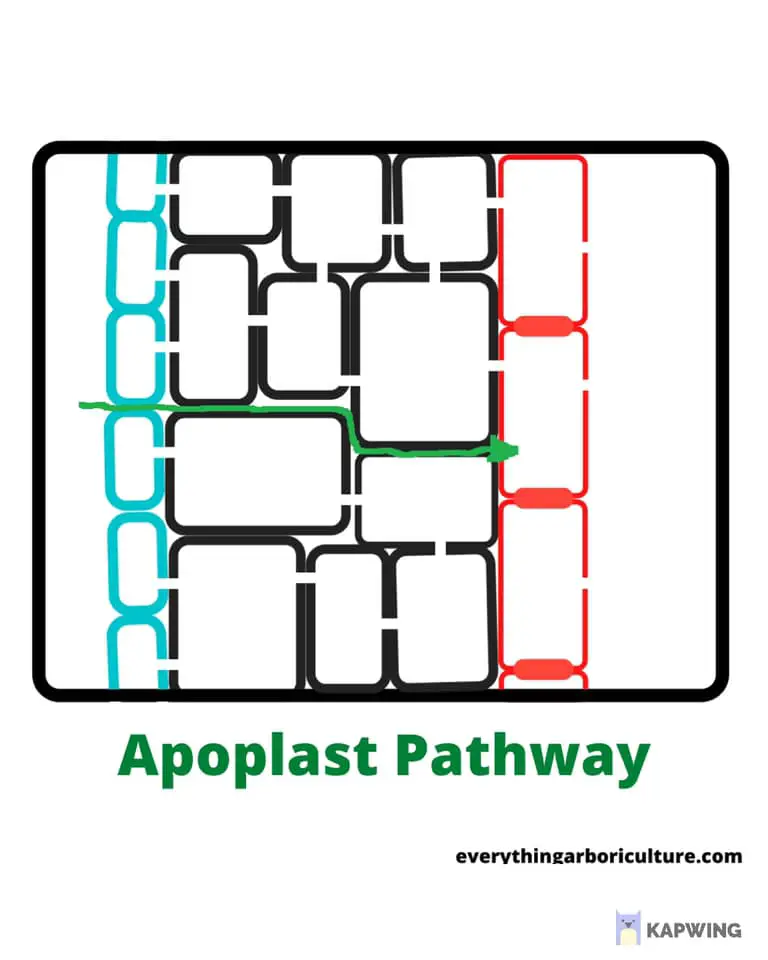
Symplastic Pathway
Between plant cells, there is something called the plasmodesmata. The plasmodesmata are like tiny bridge that connects cells. This bridge connects the cytoplasm of one cell to the cytoplasm of neighbouring cells.
The cytoplasm is the gel-like liquid inside a cell.
The plasma membrane covers all cells, and the plasmodesmata is an extension of this membrane. So, one big, continuous plasma membrane surrounds all the connected cells.
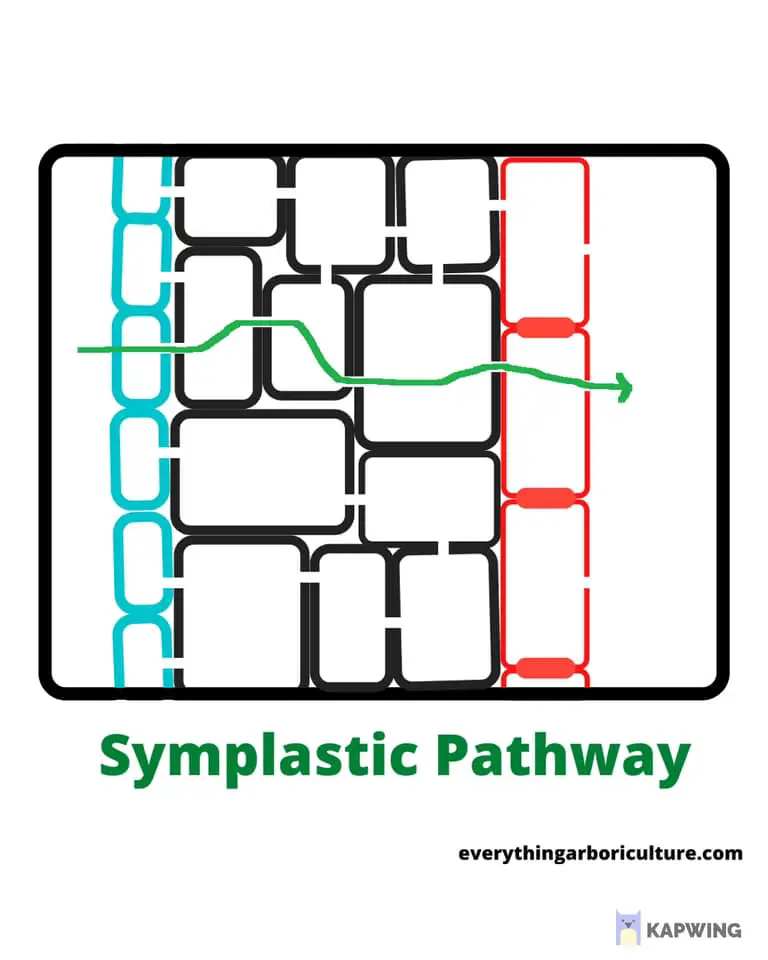
The symplast or symplasm is the continuum of communication cytoplasm, which is created by the intracellular connections.
From the Principles of Soil and Plant Water Relations, 2005:
So, the symplast is the connected plasma membrane.
Water must cross the plasma membrane to travel the symplastic pathway. Once the molecules are inside the membrane, they can travel through the cell’s cytoplasm.
The water molecules will reach the end of the cell. From here, the molecules can use the plasmodesmata (bridge) to cross to the next cell.
Water molecules will continue this process until they enter the xylem. Remember, water needs to be inside a cell to cross the endodermis. When using the symplastic pathway, the molecules are already inside a cell.
Transmembrane Pathway
The transmembrane pathway is a kind of mix between the two previous paths.
When molecules travel along the transmembrane pathway, the molecules enter and exit each cell by crossing the plasma membranes.
Water molecules will travel into each cell. But, rather than use the plasmodesmata to enter the next cell, the molecules will hop through the cell walls.
So, water will travel through the symplast by moving through interconnected cytoplasms. But, the water will also travel through the apoplast by moving through cell walls and gaps between cell walls.
Thus, the transmembrane pathway combines both apoplast and symplastic paths.
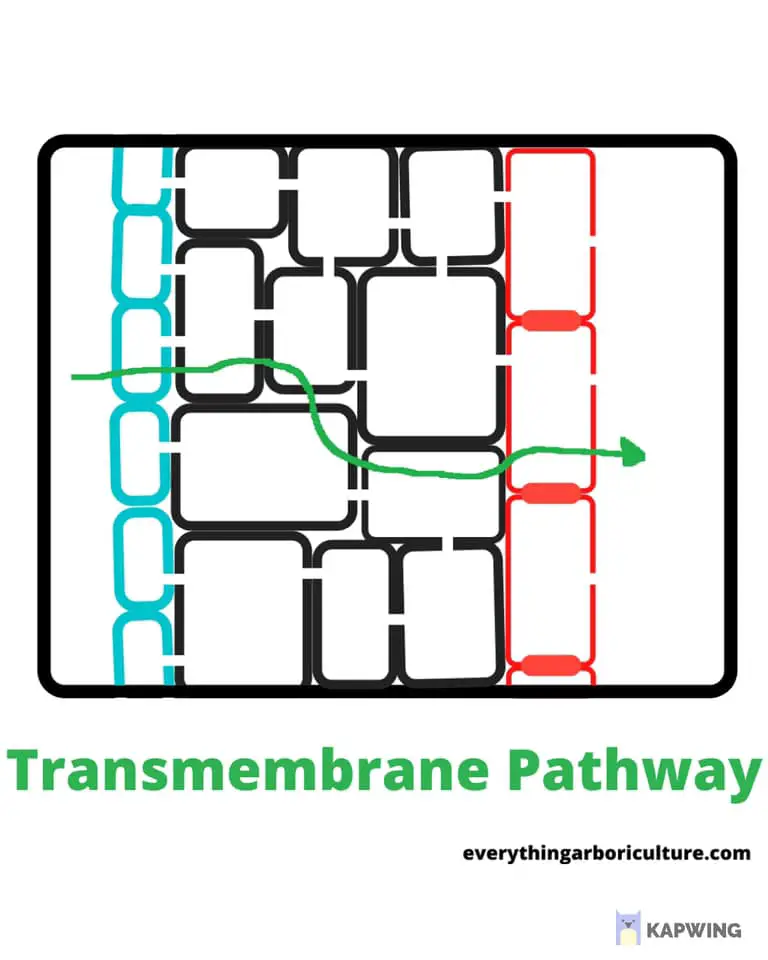
The Water Potential
The water potential of a system is the measure of the potential energy in water. In other words, it’s a measure of movement in the water – specifically, movement between two different systems.
Water potential is denoted by the Greek letter psi (Ψ) and is expressed in units of pressure called megapascals (MPa).
The water potential for pure water is 0 MPa (even though pure water can have all sorts of energy that we don’t need to account for), but for the root, stem or leaf of a plant, it would be higher than 0 MPa because it has already lost some of its pressure through contact with soil.
Ψsystem = Ψs + Ψp [ Ψs = solute potential, and Ψp = pressure potential ]
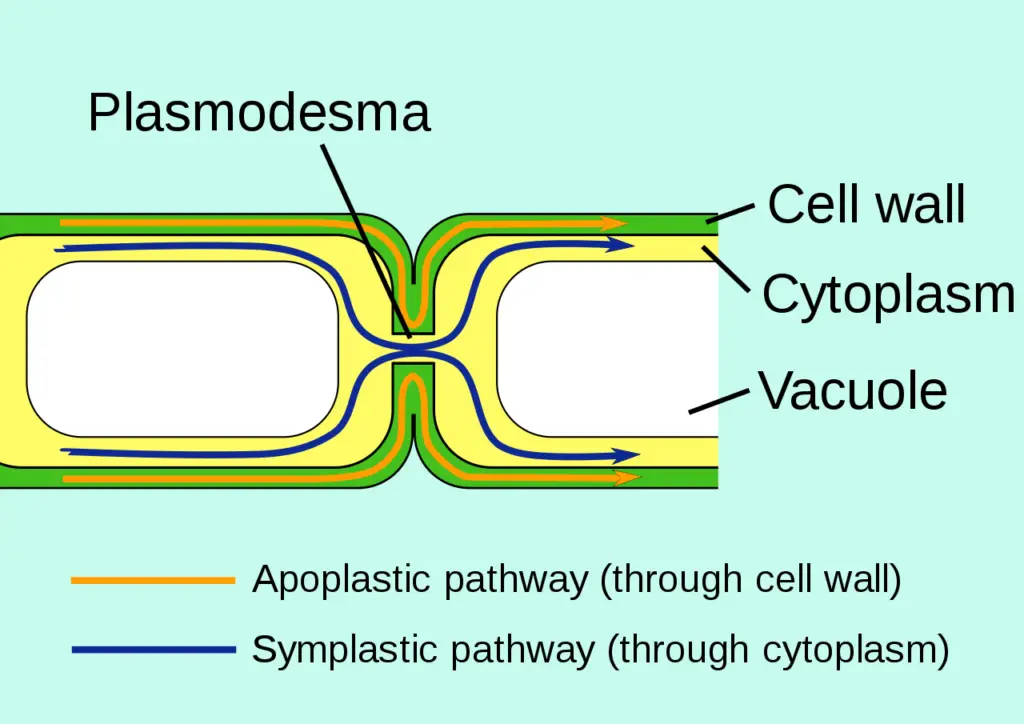
Water (green line) travels along the cell walls (blue and black) to get to the endodermis (red). Water cannot pass through the endodermis without being inside a cell. So, the water must then enter an adjacent cortical cell (black) and cross the endodermis via the plasmodesmata (gaps connecting cells)
The Role of Aquaporins in Water Movement
Aquaporins are integral membrane proteins that serve as water channels in living cells. They are found in all organisms and are essential for a variety of biological processes, including cell growth, development, and homeostasis. Aquaporins facilitate water transport across cell membranes and help regulate the hydration of cells.
There are three types of aquaporins:(PMA),(TLA) and (ERLAs)
- plasma membrane aquaporins (PMA)
- tonoplast-localized aquaporins (TLA)
- endoplasmic reticulum-localized aquaporins (ERLAs)
PMA proteins are found in the plasma membrane and play a role in regulating cell hydration and volume. TLA proteins are located in the tonoplast, which is the membrane that surrounds vacuoles. ERLAs are found in the endoplasmic reticulum and play a role in regulating calcium homeostasis.
Aquaporins are involved in a variety of water transport processes, including osmosis, transcellular transport, and ion channels. Osmosis is the diffusion of water across a semipermeable membrane from an area of high water concentration to an area of low water concentration. Transcellular transport is the movement of water across cell membranes through specialized proteins called transporters. Ion channels allow for the movement of ions, such as calcium, sodium, and potassium, across cell membranes.
Aquaporins play an important role in plant physiology. They are involved in processes such as water uptake, stomatal opening and closing, and transpiration. Aquaporins are also integral to the functioning of animal organs, such as the lungs, kidneys, and intestines.
In these organs, aquaporins facilitate the diffusion of water along osmotic gradients and regulate the passage of ions across the cell membrane. Without aquaporins, many essential physiological processes would not be possible.
Factors Affecting the Rate of Water Movement in Roots
The factors that affect the rate of water movement in roots are the surface area of the root, the level of water in the soil, and the type of soil.
The surface area of the root is important because it determines how much water can be absorbed by the root.
The level of water in the soil is important because it affects the amount of water that is available to the roots. The type of soil is important because it affects the rate at which water moves through the soil.
Conclusion
Water plays a critical role in the life of a plant, and it is essential for its survival. Roots are an important part of this process, as they act as conduits to bring water up from the soil into the rest of the tree or shrub.
Understanding how water moves through roots can help us better understand the physiology and ecology of plants, and why certain species may be more resistant to drought or flooding than others.
With further exploration into pathways of water movements in roots, we will have even greater insight into these complex processes.
